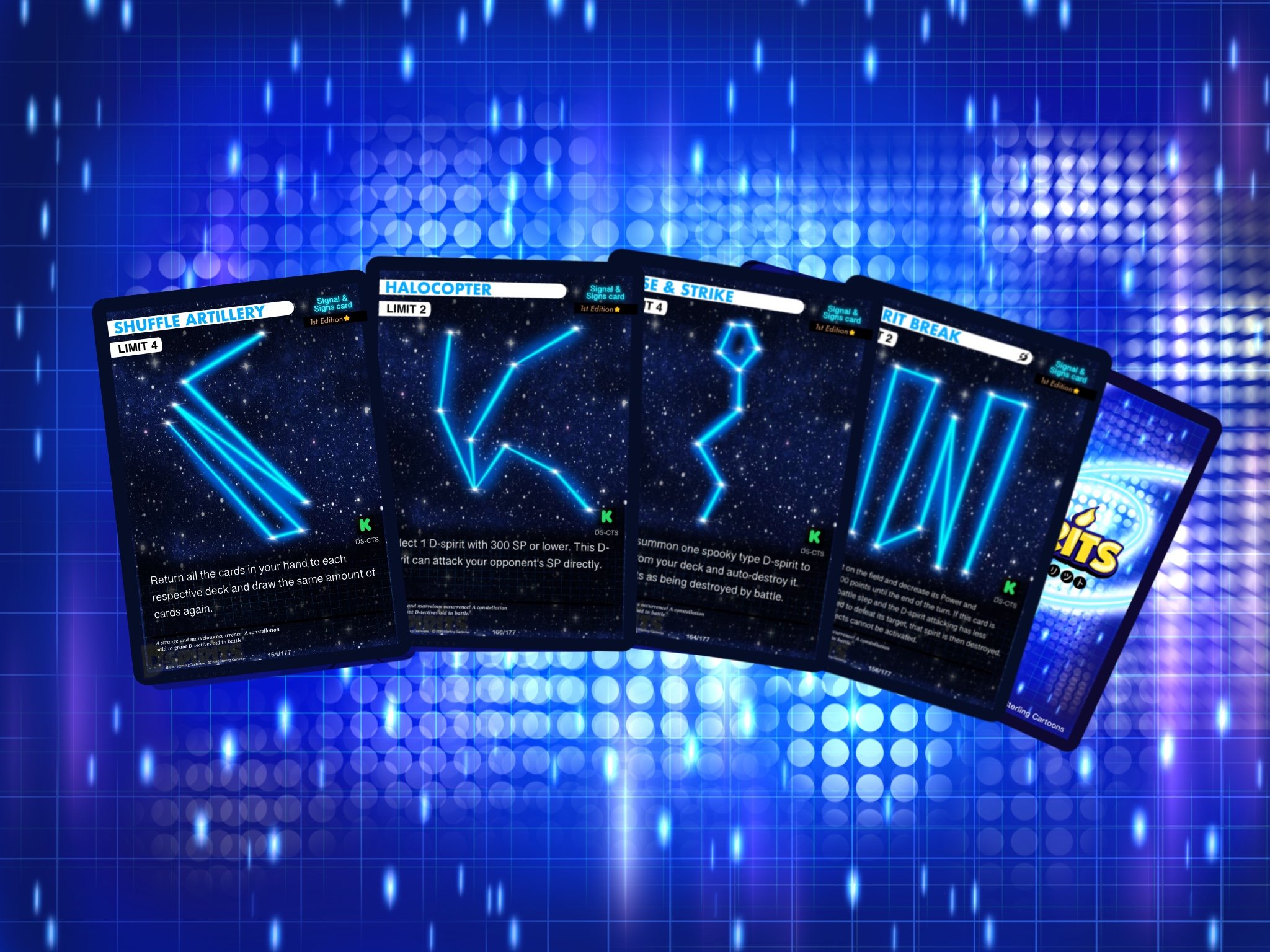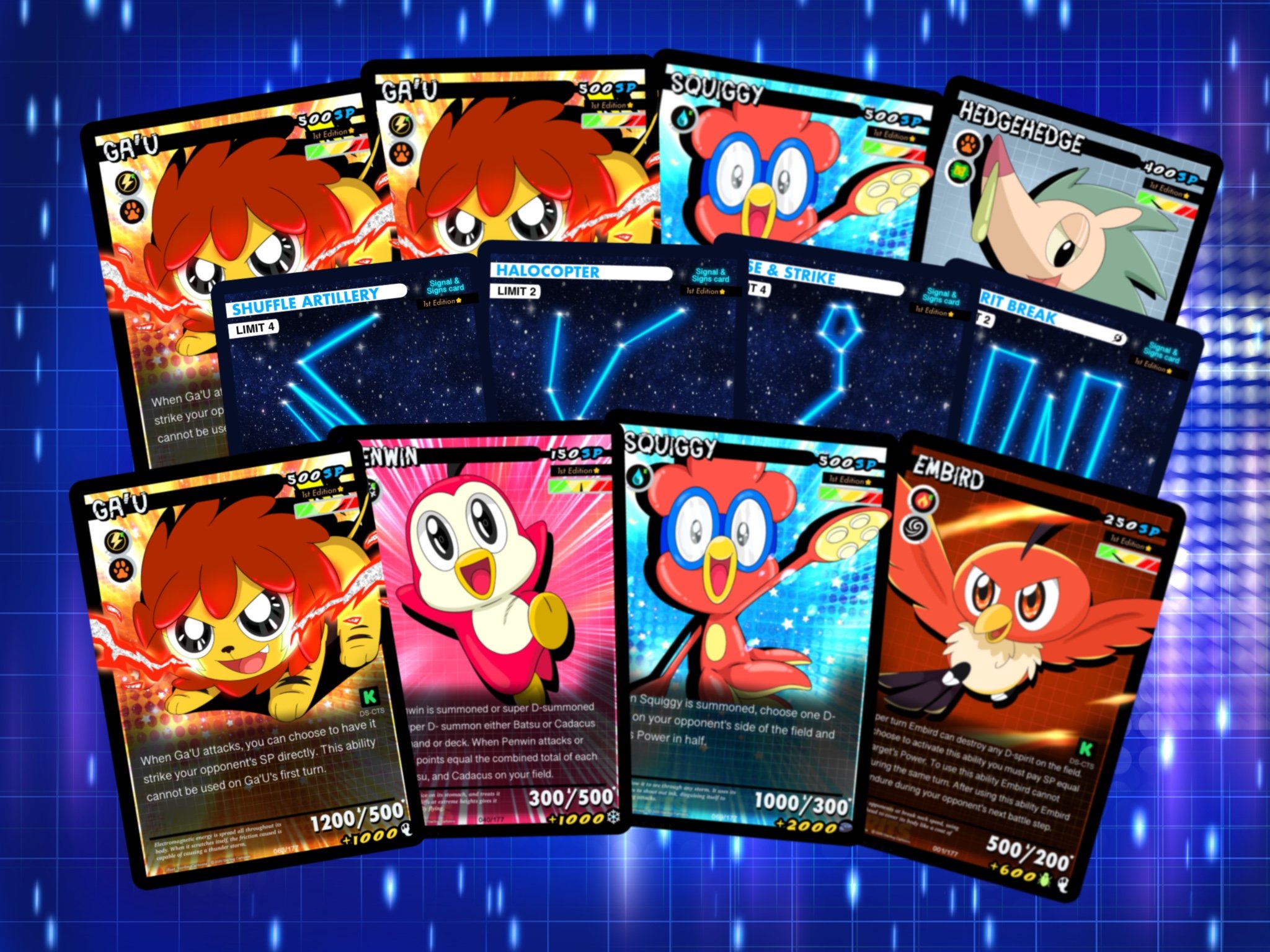Updated Mon Feb 21 2022 2:35 PM ( Rules now reflect new card interface, Realm & Special Move card rules added, updated side deck rules, updated battle step rules).
Updated Mon Nov 13 2023 2:04 PM ( Both players draw the beginning of the game and not their respective first turns, Extra Draw modified, D-Spirits now feature limits, the Signals and Signs deck is now treated as the Support deck).
Hello D-tectives! Welcome to the official game rules for the D-Spirits Trading Card Game! We highly suggest watching the video demonstration that we’ve prepared for you so you can get a hang of how the D-Spirits Card Game is played. Afterwards, please read below as this list will dive further in depth explaining the game and include details that may have not been shown in the demonstration video.
The D-spirit Official Trading Card Game is here! Battle with exciting and mysterious souls from the digital world! Learn how to play the Trading Card Game by watching this D-Battle between Damian and Atlus! And then afterwards get your own D-squad together!
Assemble your D-squad and face off in the ultimate battle!
Get your decks ready for play!
First things first! Before we dive deep into how the D-Spirits Card Game is officially played, we must make sure your decks are set up properly. To play D-Spirits you will need 3 kinds of decks. The “D-Squad” deck, the “Support deck”, and lastly the “Side deck”(not required).
The D-Squad Deck
This deck contains all of your D-Spirits that you plan to use in battle. You must have up to at least 15 unique D-Spirits in your D-Squad deck in order to play. No two D-Spirits in this deck can share the same name, and you can have a maximum of 20 D-Spirits in this deck.
Spirit Types and Symbols
Each D-Spirit has its own set of unique typings. The interface of each D-Spirit card lists its typing as a simplified symbol. In battle, each D-Spirit gains stats boosts when it is targeted or targets a certain type it has an advantage against.
*The green E besides Ice, Fire, Water, and Lightning stands for a secondary Elemental type attribute. (Elemental types are usually able to negate the abilities of Spooky types when destroyed in battle).
Using More Than One Of The Same D-Spirit
While no two D-Spirits in your “Squad deck” can have the same exact name, there are ways to have multiple different versions of the same D-Spirit in your Squad deck.
The Support Deck
The Support deck consists of 10-20 cards. Unlike the Squad deck which features only D-Spirits, the cards in this deck contain power effects and abilities to aid you during battle. Below are examples of the type of cards you would place in a Support deck. Each of these cards features a limit which lets you know how many copies can be stored in your deck at once. (Support cards are any cards that are not considered D-Spirits).
Signal and Signs Cards
Assist cards; whether it be lowering stats, negating attacks or effects; these cards truly feature stellar game changing abilities!
Realm Cards
These are cards when placed on the Battlefield, change the scope of the environment. Realm cards add additional effects that usually power up certain D-Spirit types, while also increasing/decreasing the stats of certain D-spirits as well. To play a Realm card you must bid your Spirit Points starting at whatever number is designated on the card. Your opponent has the chance to negate the activation of a Realm card if they agree to bid Spirit Points higher than you would.
The Side Deck
This deck contains up to 20 cards and can be used between battles to swap cards between the Squad deck and the Signal and Signs deck. Unlimited amounts of D-Spirit copies are allowed in this deck, however, support cards must still adhere to their deck limits.
Special Moves
Support cards that allow certain D-Spirits to perform a super charged attacks! Special Moves are usually placed in your side deck and cost Spirit Points in able to be played. Their conditions to be played are met depending on what D-Spirits are currently under your control.
Let’s Head to the D-Battlefield!!!!
The D-Battlefield consist of serval zones. These zones are where you place your different types of cards at.
The Squad deck zone (at-least 15-20 cards max. Each D-spirit must have a unique name or feature a limit).
The Support deck zone (at least 10-20 cards max. Each card has a special limit).
The Side deck zone (1-20 cards max. multiple copies allowed).
The D-world zone (your used/destroyed cards go here).
The Realm card zone (Realm cards played from either you or your opponent are placed here).
The D-Spirits battle scene (up to 4 D-spirits can be on your field at one time).
The Support Zone (Support cards get played here).
Let’s play a game!!!
Each player starts the game with an agreed amount of “Spirit Points”, or “SP” for short. Official matches are usually played with 5000 SP, but may vary. When playing with a friend, you can choose as many SP as desired. A player’s SP determines who is winning or losing the game. The first player whose SP drops to 0 loses the game.
Determine who goes first by playing a game of “rock, paper, scissors”.
During the start of the game, each player draws 7 cards. These cards can be any combination from the D-Squad deck, or the Support deck. During every turn afterwards each player is allowed to draw 1 card from either deck.
After each player’s first turn, an additional second card can be drawn during the same turn, but the player must sacrifice 500 SP (this is known as “Game breaker”, see below).
Summon your D-spirit!
After the draw step, you are now allowed to summon a D-spirit. There are two types of D-spirit summonings.
A Regular Summon
After the draw step you can summon a D-spirit from your hand to the battlefield. You are only allowed to regular summon a D-spirit once per turn.
A Super D-Summon
Super D-Summons are triggered by card effects. D-spirits summoned this way can be summoned at anytime. You can Super D-summon a D-spirit this way more than once per turn.
*During the start of the battle step only D-Spirits on the field can attack. D-Spirits that are Super D-Summoned after the battle step is started cannot attack unless stated on their ability.
Commence Battle!
D-spirits can only attack and/or destroy another D-spirit in one of two ways.
One being that the D-spirit which is attacking has power points higher than the power points of its target. ( If both D-spirits have equal amounts of power points, both D-spirits are destroyed unless the target has enough Endurance points to endure the attack; in which case the attack is then negated ).
Second, if the D-spirit attacking has higher power points than the target that’s enduring, the target is destroyed.
*During the start of the battle step only D-Spirits on the field can attack.
Endure the attack!
When a D-spirit you control is the target of an attack and would be destroyed in battle, by changing its battle stance you have the option to now allow your D-spirit to endure the attack. To do this, your D-spirit’s endurance stats must be higher than the power points of the attacking D-spirit. Enduring negates an attack during the battle, but on your next turn the D-spirit that endured cannot be “Soul-exchanged”, attack, or change it’s battle position.
Spirit Points are depleting!
There are multiple ways to deplete SP in the D-spirits card game. Some card effects require SP costs in order to be played. While other cards such as “Pixie” type D-spirits allow you to regain SP. During the game it is very important to be knowledgable of SP management.
The fastest way to get your opponent to lose SP is to attack them directly. This can only be done if your opponent controls no D-spirits on their field.
When a player’s D-spirit is destroyed in battle, the player loses SP equal to the SP of said D-spirit.
When a D-spirit targets another D-spirit with higher attack than it, the attacking D-spirit is destroyed in battle.
Battle Stances
When a D-spirit is on the field and in battle there are two positions it can assume.
Let’s take a step!
Here’s a closer look at how matches are conducted. Every turn follows a series of steps that players must follow as they flow through their turn.
*During the start of the battle step only D-Spirits on the field can attack.
Game Breakers!
Game breakers are decisions the player can make to disturb the natural flow of the match. These plays break the normal rules that are set in place in order to change the tides of battle. More game breakers will be introduced in the future, but for now, players have a few options to choose from. Have fun enjoying these game breakers, and throw your opponent off their game!
Extra Draw
After drawing one card during the draw step, one additional card from the D-squad or Support deck can be drawn, but the player must pay 500 SP.
Squad Recharge
During the draw step, if a player can no longer draw any more D-spirits (meaning that they no longer have any D-spirits in their D-Squad deck zone); by paying half of their SP, the player can take the D-spirits from their D-world and return them to their D-squad deck zone. This does not include D-spirits that are banished from the game. The deck must also be shuffled.
Soul Exchange
D-spirits that have been Super D-summoned, or that have been on the field for at least 1 turn can be returned to the hand and replaced by another D-spirit from your hand. A Soul-exchange can only take place once per turn, before the “Battle step”.
This concludes the ruleset for the D-spirits Official Trading Card Game! New rules may be added as we continue to make this the best game possible for all players. Be sure to check back every now and then for updates, and if you haven’t already, be sure to watch our D-spirts Battle tutorial for a better grasp on how to play. We’ll be seeing soon D-tectives! On the D-Battlefield!














